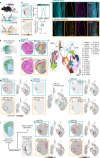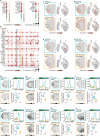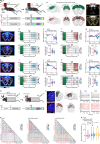Claustrum and dorsal endopiriform cortex complex cell-identity is determined by Nurr1 and regulates hallucinogenic-like states in mice
- PMID: 39289358
- PMCID: PMC11408527
- DOI: 10.1038/s41467-024-52429-9
Claustrum and dorsal endopiriform cortex complex cell-identity is determined by Nurr1 and regulates hallucinogenic-like states in mice
Abstract
The Claustrum/dorsal endopiriform cortex complex (CLA) is an enigmatic brain region with extensive glutamatergic projections to multiple cortical areas. The transcription factor Nurr1 is highly expressed in the CLA, but its role in this region is not understood. By using conditional gene-targeted mice, we show that Nurr1 is a crucial regulator of CLA neuron identity. Although CLA neurons remain intact in the absence of Nurr1, the distinctive gene expression pattern in the CLA is abolished. CLA has been hypothesized to control hallucinations, but little is known of how the CLA responds to hallucinogens. After the deletion of Nurr1 in the CLA, both hallucinogen receptor expression and signaling are lost. Furthermore, functional ultrasound and Neuropixel electrophysiological recordings revealed that the hallucinogenic-receptor agonists' effects on functional connectivity between prefrontal and sensorimotor cortices are altered in Nurr1-ablated mice. Our findings suggest that Nurr1-targeted strategies provide additional avenues for functional studies of the CLA.
© 2024. The Author(s).
Conflict of interest statement
I.F. was employee at Boehringer Ingelheim Pharma GmbH & Co. KG during the time of the study. T.I. and B.H. are employees at Boehringer Ingelheim Pharma GmbH & Co. KG. S.F. and S.G. are scientific advisors to 10x Genomics Inc, which holds IP rights to the ST technology. S.G. holds 10x Genomics stocks. All other authors report no competing interests.
Figures







References
Publication types
MeSH terms
Substances
Associated data
- Actions
- Actions
Grants and funding
LinkOut - more resources
Full Text Sources
Molecular Biology Databases

